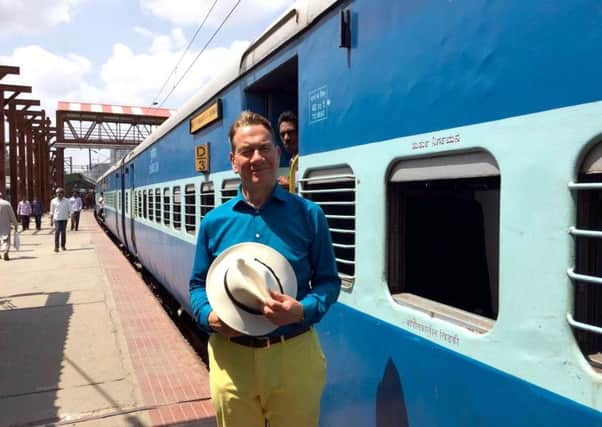Michael Portillo is right about one thing, rail is the best way to explore India


We got to the station in good time for the midnight train. As usual in India, the platform was jam-packed. Whole families – whole dynasties – were camped out, swathed in blankets, sleeping, huddling together, sharing home-made meals from aluminium tureens.
Skinny-legged porters scuttled around, two or three heavy suitcases balanced on their heads. A couple of cows ambled along, nosing through waste bins. An old man sat cross-legged on the platform playing wistful flute music.
Advertisement
Hide AdAdvertisement
Hide AdAt half past eleven, a train pulled in. “This is amazing,” I said to the man next to me. “Our train is half an hour early.” “No, no,” he said. “This is yesterday’s train. It’s 23 and a half hours late.”
Late trains are par for the course in India. Passengers are lulled into stoical acceptance by the station announcer’s standard apology: “Inconvenience caused is deeply regretted.”
I’ll be surprised if those five words aren’t cropping up somewhere in Great Indian Railway Journeys, Michael Portillo’s latest on-track series, which is currently being screened on BBC2.
Over four hour-long programmes, he’s travelling widely across the sub-continent, taking in Shimla, the old British hill station, and the celebrated Golden Triangle (Delhi, Jaipur and Agra, home of the Taj Mahal). As ever, he’s togged out in clothes of eyeball-blasting brightness: India’s reputation for vivid colour has finally found its match.
Advertisement
Hide AdAdvertisement
Hide AdWith luck, by the time they reach Kolkata, the programmes will have corrected a widespread misconception about Indian trains – that passengers usually cling to the sides of the carriages, sit on the roof and bring their goats.
Most Western passengers travel (goat-free) in air-conditioned First Class compartments on express trains (some of which have Ladies Only carriages). First Class is pricey by Indian standards, but cheap for Westerners: a 500-mile journey costs around £30. If you opt for the lowest class, it will cost you less than £3 – and will undoubtedly be a memorable, if not over-comfortable, adventure.
Local trains are cheaper still. A couple of years ago, my wife and I travelled on the Kangra Valley Railway, a little-known but wonderfully scenic North Indian hill railway. The whole 100-mile journey costs about 40p – less than the price of a second class British postage stamp. Mind you, it does take just short of ten hours.
We’ve been travelling on Indian trains for well over 20 years. A few of our trips have been on luxury train tours, which ferry you around in cosseted splendour, and we’ve done all three major hill station lines: the Shimla one, Darjeeling and Ooty (now unhelpfully renamed Udhagamandalam).
Advertisement
Hide AdAdvertisement
Hide AdMost of the time, though, we’ve travelled on “ordinary” expresses, rarely opting for First Class. Its four-berth compartments – which you may find yourself sharing with a brigadier or a VIP politician – can isolate you from the freewheeling sociability which is the essence of Indian train travel. That’s easier to find in air-conditioned Second Class, with its let-down bunks curtained off along an open corridor.
There was plenty of that sociability on our 2,300-mile rail journey across the sub-continent a few years ago. We took a series of five sleeper trains from the most westerly station on the regular passenger network – Okha in the state of Gujarat, 100 miles down the coast from Pakistan – to the most easterly one, Ledo in Assam, less than 20 miles from the Burmese border.
As we stopped at or trundled through more than 600 stations, the owner of a “spicy snacks” factory told us about the digestive benefits of sugar beet, a 17 year old shoe cleaner described his working day travelling 200 miles on trains to and from his village, and a bank official extolled the virtues of Wordsworth and Assam tea. “The small things I have told you may be of immense use,” he said as he got off.
The journey gave us plenty of time to enjoy the delights of Indian rail travel, including the meals – simple sloppy curries, looking grim but tasting delicious. Or the afternoon dozes on the top bunk, serenaded by the snores of fellow dozers.
Advertisement
Hide AdAdvertisement
Hide AdOr watching the Indian landscape drift past – the shepherds with their flocks, the women sashaying gracefully across the fields. Dashing anxiously to platform tea stalls. The toilets, admittedly, aren’t a highlight, but you just need a good aim.
Sometimes in hotels in Indian cities, you wake in the night and can hear the distant hoots of trains in the darkness. I can never hear them without wanting to be on them.
Cox & Kings (020 3642 0861, coxandkings.co.uk) has a 13-day / 11-night escorted tour of the Golden Triangle and Shimla, including two express train journeys and a journey on the “toy train” hill railway to Shimla. Priced from £2,120 per person, it includes flights, transfers, excursions and accommodation with breakfast daily.